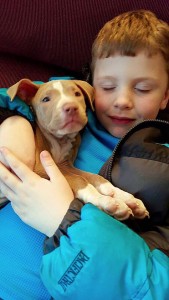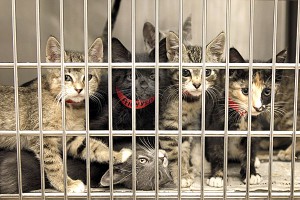This report was submitted by Sam’s Mom, Amy.
He recognized her after six years of being lost!
I found Sam as a feral kitten. He was the only kitten left in a litter that had been killed by a neighborhood dog. When I finally caught him he was a nasty little ball of hissing fluff, but he was safe. Eventually he came around and became a little more trusting of humans. I moved 3 hours away from my hometown where I lived with my significant other at the time out in the country and Sam was happy. He loved it there because he could be indoors but still go outdoors when he wanted. He had never really been able to adjust to being a strictly indoor cat.
I worked at the local animal shelter and I got all of my pets microchipped while I worked there. I learned that it was such a wonderful way to protect my pets that I loved so very much. When my relationship ended I needed to move back to my hometown but I knew that Sam would be miserable there. I would be living in town, where it wouldn’t be safe for him to be outside. It was a heartbreaking decision but at the time, what I felt would be the best option for his happiness. I know now that I was pretty naive to think that. In almost every instance, no one else is going to love your pet as much as you do…. I kept his microchip info in my name and updated it to my new info.
I found out that shortly after moving that my ex, for whatever reason, had to move and he just left Sam there. I made several trips back and forth, putting up signs around town and at the shelter where I used to work. I contacted the animal control officers and had them set out live traps as well as ride thru from time to time when they could. 6 years passed and every time I moved or got a new phone number, I updated his microchip info. Then one day, out of the blue, I got a call from that old shelter saying they had a cat named Sam there whose microchip was registered to me. He had been turned in by an elderly lady as her cat. She wanted him put down because he bit her! They said he acted quite feral and he was very sick. Luckily, instead of just taking her at her word, they managed to scan Sam for a chip.
I moved or got a new phone number, I updated his microchip info. Then one day, out of the blue, I got a call from that old shelter saying they had a cat named Sam there whose microchip was registered to me. He had been turned in by an elderly lady as her cat. She wanted him put down because he bit her! They said he acted quite feral and he was very sick. Luckily, instead of just taking her at her word, they managed to scan Sam for a chip.
Six years he’d been gone. Had he turned feral again? Would he remember me? Was he going to be ok? I took a day off and rushed the three hours back to to pick him up. When I got there I walked up to the cage and he was huddled up in the back corner hissing. I called him “Sam Sam” as I used to do and he instantly walked to the front and I rubbed his head thru the bars. He was really snotty and sneezy and a little underweight but I’d imagined a lot worse on my long trip there. He was still my Sam Sam. He remembered me. I was so happy to have him back. We made the long trip back and many many trips later to the vet he was finally on the mend. He still hates being indoors all the time but he is now an indoor only cat.
He’s 13 now and still as frisky and playful as he ever was. No he’s not happy about not being able to go outside and he watches doors like a hawk just trying to catch a moment to dart out but we are very careful. We keep him busy with lots of toys and windows to lay in. This was all about three years ago and he is doing well. Happy and healthy and very much loved. He is affectionately nicknamed Sam the ginger-haired jerk. He shares a home with a 13 year old female cat I rescued from my old shelter, a 13 year old min pin and a 5 year old rat terrier. A crazy happy little family
OBJECT LESSON:
1 Get your pet microchipped!
2. Keep the microchip registration up to date!
3. If you find a pet and the microchip information is outdated, Pet FBI may be able to help.you. We have a volunteer who has access to non-public subscription databases. He can cross reference and usually can come up with current contact info. Just use the contact link at the bottom of this page.





